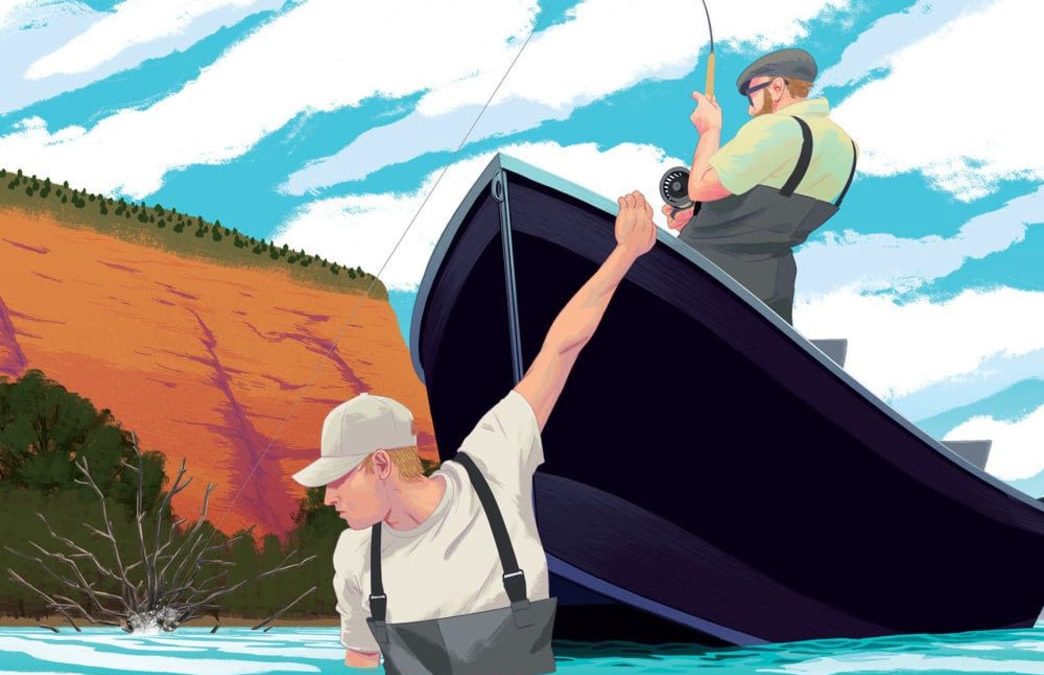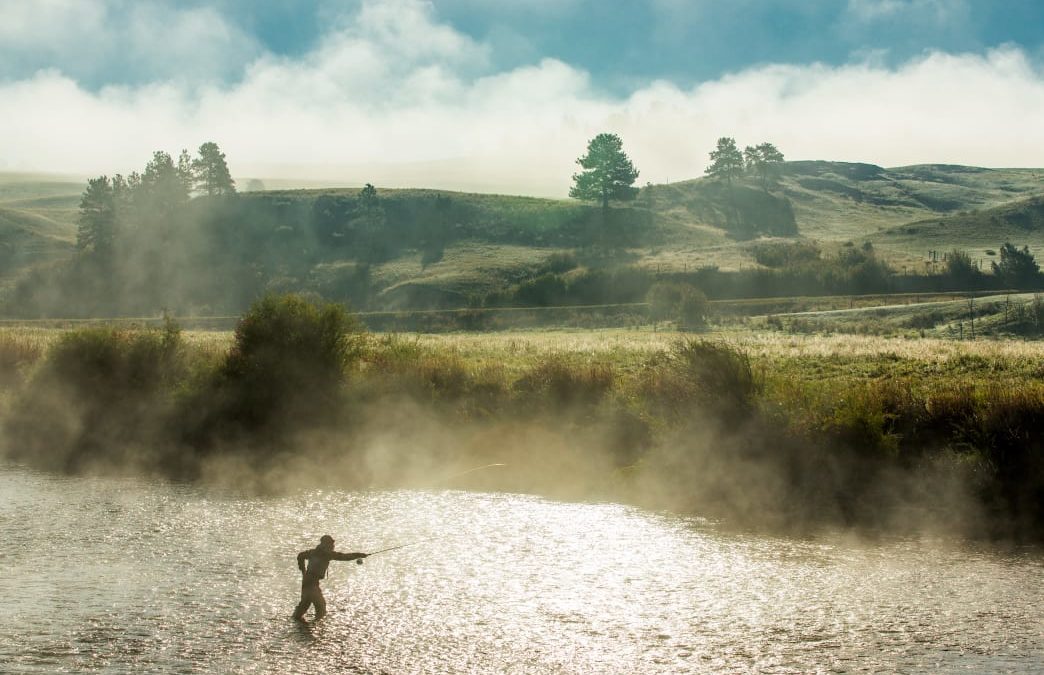
A Father-Son Flyfishing Trip In Montana
I’m gonna ferry across the river,” my guide said. “Some pocket water I want you to hit.”
“Sounds good,” I replied.
I gazed downstream. Montana’s Bighorn River is big water, but it was flowing higher than usual, and I hadn’t seen much of what I’d call “pocket water” yet. But I kept my eyes open and my mouth shut. It was too early in the float to question the guide. What I did see, however, was a dark gravel bar rising under the drift boat and a plume of water pouring over the ledge into a deep green hole the size of my front yard. I didn’t want to scuttle the guide’s float plan, but I wasn’t going to pass up a giant fishy-looking lair either.
I cast a white articulated fly my guide had handed me earlier, and dropped it into the billowing pillow of water above the gravel bar. The leechlike blob rode the flow like a kid on a pool slide—I could see why he called his creation the Wet Sock—but the second it sank to the green abyss below, a fish hit and bent the rod. Not bad when the first fish of the day is a Bighorn brown trout just a smidge over 16 inches.
“Heck yeah, man!” my guide hollered. “I’ve been thinking about that pocket ever since we put in.”
That’s when I nearly stuck my foot in my mouth. You call that pocket water? I thought. But the guide was my son, Jack, and we had gone a first hour without a fish—and to be honest, neither of us were sure how this day trip was going to pan out.
Jack had just spent a week at Sweetwater Guide School, a hands-on, dawn-to-dark boot camp for aspiring guides. It was his high-school graduation gift—learning how to row a drift boat and field-fix a jet outboard and calm down cranky anglers. Jack had fallen in love with flyfishing when he was 14 years old, wading Montana’s Gallatin River. Over the next few years, he pelted guides with relentless questioning from Maine to the Florida Keys. One June, on Idaho’s South Fork of the Snake River, he heard that college students worked Western rivers over their summer breaks, shuttling boats and guiding. That was the end of his future as a summer lawn-care consultant. With his Sweetwater course now over, he’d bummed a drift boat from an instructor, and I was his first real client.
“Thank you, Lord,” Jack said. “I’m not going to lie to you, Daddy. I was getting pretty nervous until you caught that fish.”
“You’re not the only one, son,” I said. “And we need to talk about your idea of pocket water.”
Wild West
When Jack walked out from under the tall Bighorn cottonwoods at the Sweetwater school base camp, I hadn’t seen him for a week, but I could tell from his loping gait that Montana had changed him—that a week on the river had given him passage of a sort that he could not yet understand but that I could not deny. He’d been bitten by the West, and wherever his river would run in the future, it would run far from home for at least a portion of his life. This is the cruel contract of parenthood: Give them roots and wings, then pray that the former hold as your child spreads the latter in relentless freedom.
With the monkey off our backs, we settled in for perhaps the finest afternoon of fishing I’ve ever had. Jack held me in the current seam as I worked the fly all the way down the gravel bar, cast by cast. We caught fish at Grey Cliffs and Suck Hole and Mike’s Cabin, and we whooped it up with every strike. Did you see that? Holy cow, man, did you see that?
Jack spoke of these places like he might describe the local parks up the street back home. He was fully immersed in the magic of Montana, the fish and the river and the wild country, as the wild dreams of a 14-year-old were coming true right in front of him.
It was just one of those days that leaves you shaking your head and checking your heart. We all get them occasionally, moments in the field when you know that this is one you will carry to your grave. The fish were biting like crazy, yes, and their runs seemed stronger and their spots more finely chiseled than ever in the Bighorn light. But more than the fishing, it was the first day that we’d floated as equals, and the sadness that came with the loss of my little boy was baptized in the gratitude that from this day forward, I would fish and hunt with this man in the boat.
Big Finish
By midafternoon, we didn’t have much longer to fish. Soon Jack would have to hit the oars hard; we had a six-hour drive to Missoula still ahead of us. But then he slowed the boat one last time.
“I want you to hit that log,” he said. “See it?”
“I think so.” It was a giant sculpture of twisted driftwood, 8 feet tall, at least. Who could miss it? But as my mouth opened for a wisecrack, my guide tucked me into range. My first cast brought a ferocious slash from the largest trout we’d seen all day, but the heavy water carried the drift boat too swiftly for a second crack.
Jack slipped overboard and pulled the drift boat 30 feet upcurrent. “I’ll hold the boat,” he said. “You just catch the fish.”
We pulled two more fish from the hole, the second one running wild like a puppy in the yard. The water likely spent, Jack pulled himself back in the boat, rowed clear of the swift current, then stowed the oars and leaned back, soaking in the sun, the moment, the river, and his future, which unfurled just about as far as the next bend in the Bighorn. If there is a finer thing than to be 17 years old on a Montana river, I can only barely imagine what that might be.
“I don’t know, Daddy,” he said, kicking his Chaco-clad feet on the cooler. He grinned over a grimy sun buff and stroked a 15-day-old beard that I could actually make out in the right slant of sunlight. “I’m thinking of keeping the ’stache, at least. Think I can pull it off?”
I started to taste my foot again, but caught myself in time. I reckon if there’s anywhere in this world that a young man can still dream, it’s Montana.
Written by T. Edward Nickens for Field & Stream and legally licensed through the Matcha publisher network. Please direct all licensing questions to legal@getmatcha.com.
Featured image provided by Field & Stream



